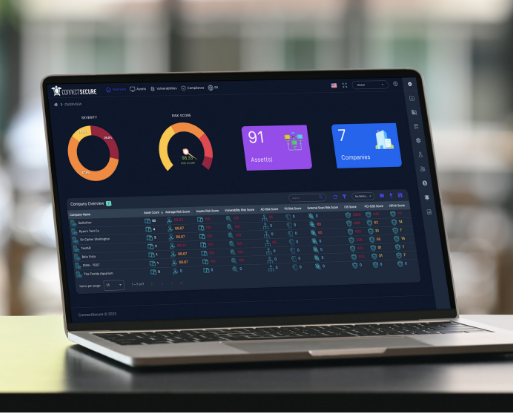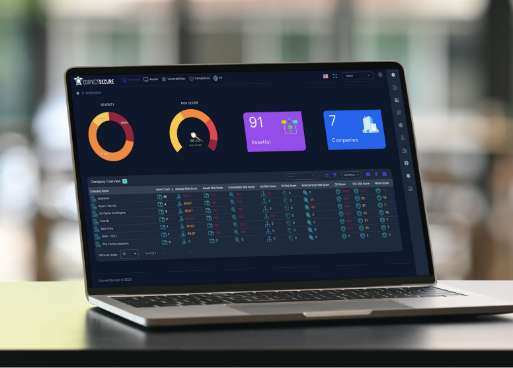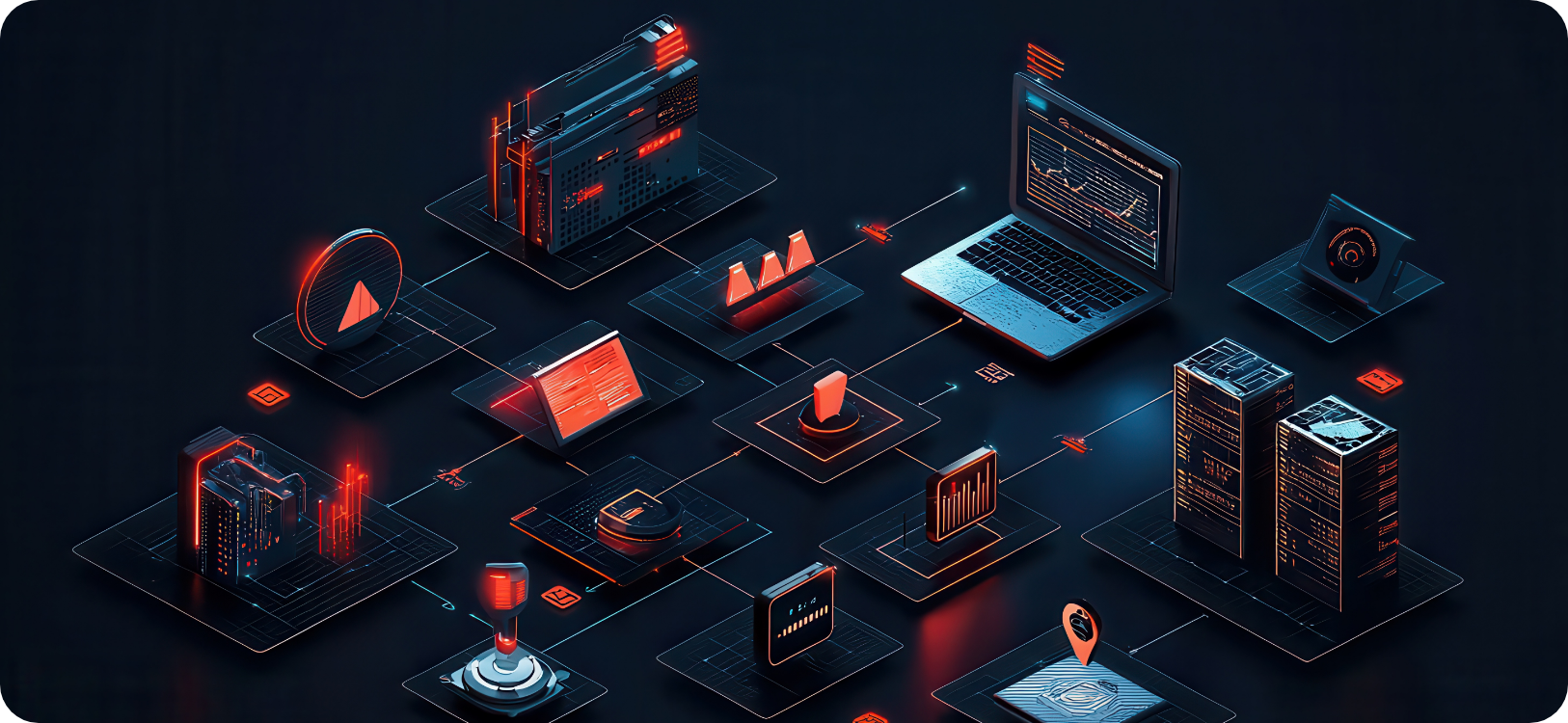IT Asset and Network Documentation
An MSP ResourceIT Asset and Network Documentation
An MSP ResourceHow to Harden the attack surface
- Introduction
- What is IT Asset and Network Documentation?
- Benefits of IT Asset and Network Documentation
- IT Asset Documentation: Core Components
- Network Documentation: Essential Elements
- Common Challenges IT Asset and Network Documentation Solves
- IT Asset Documentation for Compliance and Audit Success
- Documentation Best Practices
- ConnectSecure: Integrated Vulnerability and Asset Management
- IT Asset Documentation Implementation: Planning and Deployment
- Frequently Asked Questions
- IT Asset and Network Documentation: Your Path Forward
- Additional Resources
Introduction
Organizations lose visibility into their IT environments when assets go undocumented and unauthorized technology proliferates across networks. These blind spots expose businesses to security breaches, compliance failures, and operational disruptions that could have been prevented with proper documentation practices.
IT asset and network documentation covers all key asset classes — devices, applications, networks, data, and users — to improve client visibility. Asset documentation catalogs hardware specifications, software licenses, configurations, and ownership details. Network documentation maps connections, protocols, security policies, and infrastructure relationships.
Comprehensive documentation practices eliminate dangerous blind spots, giving organizations the visibility needed to secure their environments and maintain compliance.

What is IT Asset and Network Documentation?
IT asset and network documentation creates detailed records of technology components within an organization. Asset documentation tracks physical and digital resources, while network documentation supports the connections and configurations that enable these resources to communicate and function together.
IT Asset Documentation
IT asset documentation encompasses comprehensive records of technology hardware and software within an organization.
Hardware Assets Include:
- Servers, workstations, and mobile and network devices
- Specifications, serial numbers, warranty information, and more
- Physical locations and user assignment
Software Assets Include:
- Applications and operating systems
- Software licenses and usage rights
- Installation details and version numbers
- Digital tools and cloud services
Network Documentation
Network documentation focuses specifically on infrastructure that connects and enables communication between assets.
Key Components:
- Configuration files for routers, switches, and firewalls
- IP address assignments and subnet allocations
- Security policies and access control lists
- Bandwidth allocations and service level agreements
Effective documentation systems integrate these elements to provide visibility into IT environments, supporting security operations, compliance reporting, and strategic planning initiatives.

Experience the Power of ConnectSecure

Benefits of IT Asset and Network Documentation
Organizations that maintain comprehensive IT asset and network documentation gain significant advantages in security, operations, and cost management. These benefits extend beyond simple inventory tracking to impact every aspect of IT service delivery and business risk management.
Security Risk Reduction
Asset visibility eliminates blind spots that attackers exploit to gain unauthorized network access. When security teams know device, application, network, data, and user connections, they can implement consistent security policies and detect anomalous activity more effectively.
Key Security Benefits:
- Faster awareness through immediate asset identification
- Comprehensive vulnerability management across all systems
- Reduced attack surface by identifying unauthorized devices
- Improved patch management with complete system inventories
Operational Efficiency Gains
Documented IT environments enable faster troubleshooting and more effective resource allocation. Technical teams spend less time searching for information and more time solving problems.
Operational Improvements:
- Reduced mean time to resolution
- Streamlined change management processes
- Better capacity planning with accurate usage data
- Improved service delivery consistency
Cost Management and Optimization
Accurate asset tracking prevents duplicate purchases, identifies underutilized resources, and supports strategic technology planning. Organizations can make informed decisions about software licensing, hardware refresh cycles, and vendor relationships.
Financial Benefits:
- Elimination of redundant software licenses
- Better vendor negotiation with usage data
- Optimized hardware utilization rates
- Reduced emergency procurement costs
Compliance and Audit Readiness
Regulatory frameworks increasingly require detailed IT asset records and security documentation. Comprehensive documentation demonstrates due diligence and significantly reduces audit preparation time.
Compliance Advantages:
- Streamlined regulatory reporting processes
- Reduced audit findings and associated penalties
- Faster compliance certification renewals
- Improved insurance claim processing
Documentation practices that align with standards like ISO 19770 for IT asset management help organizations meet regulatory requirements while reducing operational risks and demonstrating commitment to proper governance.

IT Asset Documentation: Core Components
Building comprehensive IT asset documentation requires systematic tracking across multiple categories and lifecycle stages. Each component serves specific operational and compliance needs while contributing to overall IT environment visibility.
Hardware Asset Management
Hardware documentation extends beyond basic inventory lists to include detailed specifications, maintenance records, and operational context that supports decision-making.
Physical Asset Tracking:
- Asset tags and unique identifiers for inventory control
- Manufacturer warranties and service contract details
- Physical location tracking with room and rack assignments
- Ownership and custodian assignment records
Technical Specifications:
- Processor, memory, and storage capacity details
- Network interface configurations and MAC addresses
- Power consumption and environmental requirements
- Compatibility matrices for software and peripheral devices
Lifecycle Management:
- Purchase orders, warranty, and acquisition costs
- Deployment dates and configuration histories
- Maintenance schedules and service records
- End-of-life planning and disposal tracking

Boost Client Security
Software Asset Management
Software documentation requires tracking both installed applications and licensing agreements to ensure compliance and optimize costs.
License Management:
- Software entitlements and usage rights documentation
- Volume licensing agreements and compliance terms
- User assignment tracking and transfer records
Installation and Configuration:
- Software version control
- Custom configuration settings and integrations
- Dependency mapping between applications
- Performance metrics and resource utilization data
Compliance Monitoring:
- License utilization reports and optimization opportunities
- Unauthorized software detection and removal tracking
- Vendor audit preparation and evidence collection
- Cost allocation and chargeback documentation
Digital Asset Categories
Modern IT environments include various digital assets that require specialized documentation approaches.
Cloud Services and SaaS Applications:
- Subscription details and billing information
- User provisioning and access management records
- Data residency and security configuration details
- Integration APIs and service dependencies
Virtual Infrastructure:
- Virtual machine specifications and host assignments
- Resource allocation and performance baselines
- Backup and disaster recovery configurations
- Migration histories and rollback procedures
Mobile and Remote Assets:
- Device enrollment and management policies
- Application deployment and security configurations
- Remote access credentials and VPN assignments
- Compliance status and security posture monitoring
Asset Relationship Mapping
Understanding connections between assets enables better impact analysis and change management.
Dependency Documentation:
- Application-to-server relationships and resource requirements
- Network dependencies and communication protocols
- User access patterns and business function alignments
Business Context Integration:
- Critical business process alignments
- Service level agreement mappings
- Disaster recovery priority classifications
- Regulatory compliance scope assignments

Network Documentation: Essential Elements
Network documentation requires capturing both physical infrastructure and logical configurations that enable connectivity and security across IT environments. Effective network documentation includes operational procedures, security policies, and performance baselines.
Network Topology and Architecture
Comprehensive topology documentation provides technical representations of network infrastructure that support troubleshooting and planning activities.
Physical Network Mapping:
- Cable runs and connection points with labeling schemes
- Switch and router placement with rack and port assignments
- Wireless access point locations and coverage areas
- Fiber optic and copper cabling specifications
Logical Network Structures:
- VLAN assignments and segmentation policies
- Routing protocols and path redundancy configurations
- Quality of Service (QoS) policies and traffic prioritization
- Network address translation (NAT) and firewall zones
Site-to-Site Connectivity:
- Wide area network (WAN) connections and bandwidth allocations
- VPN tunnels and encrypted communication channels
- Internet service provider details and failover configurations
- Cloud connectivity and hybrid infrastructure links

See ConnectSecure in Action
Device Configuration Management
Network device configurations require detailed documentation to ensure consistent performance and enable rapid recovery during failures.
Router and Switch Configurations:
- Interface assignments and port configurations
- Routing table entries and static route definitions
- Spanning tree protocol settings and loop prevention
- Access control lists and traffic filtering rules
Security Device Settings:
- Firewall rule sets and policy enforcement
- Intrusion detection and prevention system configurations
- Load balancer settings and traffic distribution algorithms
- SSL certificate management and encryption protocols
Wireless Network Parameters:
- Access point configurations and channel assignments
- Authentication methods and security protocols
- Guest network isolation and bandwidth limitations
- Roaming policies and seamless connectivity settings
IP Address Management and Allocation
Systematic IP address documentation prevents conflicts and supports network expansion planning.
Address Space Planning:
- Subnet allocations and network segmentation schemes
- DHCP scope definitions and reservation policies
- Static IP address assignments for critical systems
- IPv6 implementation and dual-stack configurations
DNS and Domain Management:
- Forward and reverse DNS zone configurations
- Domain name registration and renewal tracking
- Certificate authority relationships and trust chains
- Dynamic DNS update policies and security controls
Network Security Policy Documentation
Security policies require detailed documentation to ensure consistent implementation and compliance verification.
Access Control Policies:
- User authentication and authorization procedures
- Network access control (NAC) implementation details
- Privileged access management for network devices
- Remote access policies and monitoring procedures
Monitoring and Incident Response:
- Network monitoring thresholds and alerting configurations
- Incident response procedures and escalation paths
- Log collection and analysis procedures
- Forensic data preservation and chain of custody protocols
Compliance and Audit Requirements:
- Regulatory compliance mapping and control documentation
- Security assessment schedules and remediation tracking
- Vendor security requirements and validation procedures
- Data classification and handling policies

Common Challenges IT Asset and Network Documentation Solves
Organizations face significant operational and security challenges when IT assets and network infrastructure remain undocumented or poorly tracked. Comprehensive documentation practices address these widespread problems that affect most IT environments.
Documentation Drift and Outdated Information
IT environments change constantly, but documentation often fails to keep pace with these modifications. Teams make configuration changes, deploy new systems, and modify network settings without updating corresponding documentation, creating information gaps that grow over time.
Shadow IT and Unknown Assets
Individuals regularly introduce unauthorized devices and applications into corporate networks without IT department knowledge. These undocumented assets create security vulnerabilities and compliance gaps that organizations discover only during incidents or audits.
Tribal Knowledge Dependencies
Critical system information often exists only in the minds of individual team members rather than documented procedures. When key personnel leave or become unavailable, organizations lose access to important operational knowledge needed for maintenance and troubleshooting.
Incident Response Delays
Technical teams waste valuable time during outages searching for asset information, configuration details, and troubleshooting procedures across multiple systems and locations. Lack of centralized documentation significantly increases mean time to resolution.
Compliance and Audit Preparation Difficulties
Organizations struggle to gather required documentation for regulatory audits, often spending weeks collecting asset inventories, security configurations, and evidence of control implementation from disparate sources.
Inefficient Resource Allocation
Without accurate asset tracking, organizations make poor purchasing decisions, maintain redundant systems, and fail to optimize software licensing costs. Lack of visibility into asset utilization leads to wasted resources and missed cost savings opportunities.
Systematic IT asset and network documentation practices eliminate these challenges by providing centralized, accurate, and current information that supports all aspects of IT operations and governance.

IT Asset Documentation for Compliance and Audit Success
Key Regulatory Documentation Requirements
NIST Cybersecurity Framework & NIST 800-53 Controls:
- Maintain an accurate asset inventory aligned to NIST Identify (ID.AM) controls
- Document asset ownership, roles, and authorized access
- Track asset configurations and required security measures
- Support continuous monitoring and evidence collection for audits
GDPR Data Asset Tracking:
- Document all systems that process, store, or transmit personal data
- Maintain records of data flows and cross-border transfers
- Track data retention schedules and automated deletion procedures
- Provide evidence of technical and organizational security measures
ISO 19770 Asset Management Standards:
- Maintain structured software asset inventories with usage tracking
- Document software licensing agreements and compliance status
- Implement lifecycle management from acquisition to disposal
- Establish audit trails for all asset-related decisions and changes
Industry-Specific Requirements:
- Healthcare organizations need HIPAA-compliant asset documentation
- Financial services require SOX controls documentation for IT systems
- Government contractors must meet FedRAMP documentation standards
- Manufacturing companies often need ISO 27001 security documentation

Elevate Your MSP Services
Compliance Benefits of Asset Documentation
Improved Compliance and Audit Readiness: Compliance remains vital for IT asset management processes. IT asset management process documentation ensures practices align with standards like NIST, GDPR, and ISO 19770, reducing risks during audits and demonstrating commitment to proper asset management.
Audit Preparation Advantages:
- Automated generation of required asset inventories and reports
- Immediate access to historical data and change documentation
- Demonstrated due diligence through systematic tracking procedures
- Reduced audit findings through proactive gap identification
Risk Mitigation Outcomes:
- Lower regulatory penalty exposure through documented controls
- Faster incident response with complete asset visibility
- Improved insurance claims processing with detailed asset records
- Enhanced vendor management through comprehensive documentation
Asset documentation transforms compliance from a reactive burden into a proactive business advantage that supports operational excellence and risk management.

Documentation Best Practices
Effective IT asset and network documentation requires systematic approaches that ensure accuracy, accessibility, and long-term sustainability. Organizations that implement structured documentation practices achieve better compliance outcomes and operational efficiency.
Establish Clear Documentation Standards
Consistency across documentation efforts enables teams to find information quickly and maintain accuracy over time.
Naming Conventions and Taxonomies:
- Standardized naming schemes for devices, networks, and files
- Consistent asset classification categories and priority levels
- Uniform labeling for physical and cloud network components
- Structured folder hierarchies and document organization systems
Template Development and Standardization:
- Standardized forms for different asset types and configurations
- Consistent data fields and required information elements
- Template libraries for common documentation scenarios
- Version control procedures for template updates and improvements
Data Quality Standards:
- Required fields and mandatory information elements
- Data validation rules and acceptable value ranges
- Regular data cleansing and accuracy verification procedures
- Exception handling for incomplete or conflicting information
Implement Documentation and Automated Discovery
Fast-moving IT environments demand automated discovery to keep documentation current and useful.
Automated Asset Discovery:
- Network scanning tools that identify devices and configurations
- Software inventory systems that track installed applications
- Cloud resource discovery across multiple service providers
- Real-time monitoring for new devices
Configuration Management Automation
- Automated backup of network device configurations
- Change detection and alerting for unauthorized modifications
- Version control for configuration files and documentation updates
- Rollback procedures for configuration errors and failures
Integration with Existing Systems:
- ITSM platform integration for ticket and change management
- Monitoring system connections for performance and availability data
- Security tool integration for vulnerability and compliance information
- HR systems such as CRM, HR, accounting, etc., connections for user and ownership assignments

Ready to Drive Business With Vulnerability Management?
Maintain Documentation Accuracy and Currency
Documentation loses value quickly when information becomes outdated or inaccurate.
Regular Review and Validation Cycles:
- Scheduled audits of documentation accuracy and completeness
- Quarterly reviews of asset inventories and ownership assignments
- Annual comprehensive documentation assessments
Eliminate Tribal Knowledge Dependencies
Organizations that rely on individual expertise face significant risks when key personnel leave or become unavailable.
Knowledge Transfer Procedures:
- Structured documentation templates that capture institutional knowledge
- Regular knowledge sharing sessions and documentation reviews
- Cross-training programs that include documentation responsibilities
- Succession planning that includes documentation handover requirements
Standardized Procedures Documentation:
- Step-by-step procedures for common maintenance and troubleshooting tasks
- Decision trees for incident response and problem resolution
- Escalation procedures and contact information for specialized support
- Emergency procedures that can be executed by any qualified team member
Centralized Information Management:
- Single source of truth for all IT asset and network documentation
- Searchable repositories with effective indexing and categorization
- Access control systems that ensure appropriate information availability
- Backup and recovery procedures for documentation systems

Boost Client Security
User Adoption and Training Strategies
Documentation systems succeed only when teams consistently use and maintain them.
Training and Education Programs:
- Initial training for new team members on documentation procedures
- Regular refresher training on updated processes and system changes
- Specialized training for advanced documentation features and capabilities
- Certification programs that validate documentation competency
Workflow Integration:
- Documentation tasks embedded in daily operational procedures
- Performance metrics that include documentation quality and timeliness
- Recognition programs that reward excellent documentation practices
User Experience Optimization:
- Intuitive interfaces that minimize documentation effort
- Mobile-friendly access for field technicians and remote workers
- Search capabilities that help users find information quickly
- Feedback mechanisms for continuous improvement of documentation systems
Documentation Governance and Oversight
Effective governance ensures documentation practices remain aligned with organizational objectives and compliance requirements.
Roles and Responsibilities:
- Clear ownership assignments for different documentation categories
- Documentation coordinators who oversee quality and consistency
- Regular management reviews of documentation effectiveness
- Accountability mechanisms for documentation maintenance requirements
Quality Assurance Processes:
- Peer review procedures for critical documentation updates
- Automated quality checks for data completeness and accuracy
- Regular audits of documentation practices and outcomes
- Continuous improvement programs based on user feedback and metrics

ConnectSecure: Integrated Vulnerability and Asset Management
ConnectSecure delivers comprehensive IT asset and network documentation through a unified platform that combines vulnerability management with asset visibility. The integrated approach eliminates the need for separate tools while providing MSPs and IT organizations with context-rich information that streamlines operations and improves security outcomes.
Unified Platform Architecture
ConnectSecure Asset and Network Documentation operates through a single, lightweight agent that performs both vulnerability scanning and complete asset discovery simultaneously.
Single Agent Deployment:
- Automated asset discovery and vulnerability scanning from one installation
- Automated asset population as new devices join the network
- Elimination of multiple agent deployments and management overhead
- Reduced system resource consumption compared to separate tools
Integrated Data Repository:
- Centralized storage of vulnerability data alongside asset documentation
- Automatic correlation between discovered vulnerabilities and affected assets
- Real-time updates as network configurations and asset details change
- Unified reporting that combines security and operational information
Asset Discovery and Documentation
The platform automatically captures and organizes detailed information about IT infrastructure, creating a complete inventory.
Automated Asset Capture:
- Hardware specifications, serial numbers, and warranty information
- Software installations, versions, and configuration details
- User assignments, ownership details, and location tracking
Configuration Management Integration:
- Network device configurations and firmware versions
- Security policies and access control documentation
- Change history tracking
- Standard operating procedures and troubleshooting guides
Document Storage and Organization:
- Centralized repository for policies, procedures, and documentation
- Version control and approval workflows for critical documents
- Search capabilities across all documentation types

See ConnectSecure in Action
Context-Rich Vulnerability Management
ConnectSecure transforms vulnerability management by providing complete asset context alongside security findings, enabling faster and more accurate remediation decisions.
Vulnerability-Asset Integration:
- Direct mapping between CVEs and specific affected assets
- Asset criticality information alongside vulnerability severity scores
- Business function context for prioritizing remediation efforts
- Historical patch data and previous remediation activities
Enhanced Prioritization Capabilities:
- Risk scoring that combines vulnerability severity with asset importance
- Client-specific prioritization based on business requirements
- Public-facing asset identification for expedited response
- Dependency mapping to understand potential impact scope
Streamlined MSP Operations
The integrated platform reduces manual work while providing MSPs with the information needed for efficient client service delivery.
Operational Efficiency Features:
- Instant access to credentials, configurations, and procedures from vulnerability reports
- Automated documentation updates as assets are discovered or modified
- Elimination of shadow IT through continuous network monitoring
- Reduced troubleshooting time with comprehensive asset context
Client Service Enhancement:
- Faster incident response with immediate asset information access
- Improved change management through complete dependency visibility
- Enhanced compliance reporting with integrated asset and security data
- Professional documentation that demonstrates thorough IT governance
Compliance and Regulatory Support
ConnectSecure’s integrated documentation approach supports compliance requirements by maintaining detailed audit trails and asset inventories that demonstrate regulatory adherence.
Compliance Documentation Features:
- Alignment with NIST and CIS asset identification controls
- Automated generation of asset inventories for regulatory reporting
- GDPR compliance support through detailed tracking of systems processing personal data
- ISO 19770 alignment with structured asset management documentation
- Audit-ready reports that combine security findings with asset context
Regulatory Alignment Benefits:
- Reduced audit preparation time through centralized documentation
- Demonstrated due diligence with comprehensive asset tracking
- Streamlined compliance reporting across multiple frameworks
- Evidence collection for regulatory inquiries and assessments
ConnectSecure Asset and Network Documentation provides organizations with the comprehensive visibility needed to secure IT environments while maintaining operational efficiency and regulatory compliance. The platform’s integrated approach eliminates tool sprawl and provides the context necessary for effective decision-making in complex IT environments.

IT Asset Documentation Implementation: Planning and Deployment
Building effective IT asset and network documentation benefits from a phased approach that demonstrates value quickly while establishing sustainable processes for long-term success.
Assessment and Planning Phase
Start by evaluating current documentation practices and identifying critical gaps that pose the highest risk to operations and compliance.
Current State Analysis:
- Inventory existing documentation sources and quality levels
- Identify critical systems with inadequate or missing documentation
- Assess team skills and available resources for documentation initiatives
- Determine regulatory and compliance requirements that drive documentation needs
Priority Setting:
- Focus initial efforts on business-critical systems and high-risk assets
- Target areas where documentation gaps cause frequent operational problems
- Align documentation priorities with upcoming audit or compliance deadlines
- Consider quick wins that demonstrate immediate value to stakeholders
Phased Rollout Approach
Implement documentation practices gradually to avoid overwhelming teams while building momentum through early successes.
Phase 1: Critical Infrastructure
- Document core network infrastructure and security configurations
- Create asset inventories for servers and critical business applications
- Establish basic procedures for maintaining documentation accuracy
- Implement automated discovery tools for foundational visibility
Phase 2: Expanded Coverage
- Extend documentation to workstations and mobile devices
- Add software licensing and compliance tracking
- Integrate documentation with change management processes
- Develop comprehensive troubleshooting and maintenance procedures
Phase 3: Advanced Integration
- Connect documentation systems with monitoring and security tools
- Implement automated workflows for documentation updates
- Add advanced reporting and analytics capabilities
- Establish continuous improvement processes and regular reviews

Elevate Your MSP Services
Change Management and Adoption
Success depends on team adoption and consistent use of documentation practices.
Training and Support:
- Provide comprehensive training on documentation tools and procedures
- Create simple templates and guides that reduce documentation effort
- Establish clear accountability for documentation maintenance responsibilities
- Recognize and reward teams that maintain high-quality documentation
Process Integration:
- Embed documentation requirements into existing workflows
- Make documentation updates mandatory for all change requests
- Include documentation quality in performance reviews and assessments
- Use automation to reduce manual effort and improve accuracy
Organizations that follow systematic implementation approaches typically achieve full documentation coverage within 12–18 months while seeing immediate benefits in operational efficiency and risk reduction.

Frequently Asked Questions
What is the difference between IT asset documentation and network documentation?
IT asset documentation focuses on cataloging individual technology resources like servers, software, and devices with their specifications, ownership, and lifecycle information. Network documentation maps how these assets connect and communicate, including topology diagrams, configurations, and security policies. Both work together to provide complete IT environment visibility.
How often should IT asset and network documentation be updated?
Documentation should be updated continuously through automated discovery tools and integrated change management processes. Critical systems may need real-time updates, while less critical assets can be reviewed monthly or quarterly. The key is establishing automated processes that reduce manual effort while maintaining accuracy.
What compliance standards require IT asset documentation?
Major standards include GDPR for data protection, ISO 19770 for IT asset management, ISO 27001 for information security, and industry-specific regulations like HIPAA for healthcare or SOX for financial services. Requirements vary by industry, but most frameworks now mandate detailed IT asset tracking and documentation.
How can organizations identify shadow IT through documentation practices?
Automated network discovery tools scan environments to identify all connected devices and applications, comparing findings against authorized asset inventories. Regular documentation audits reveal unauthorized software installations, personal devices, and unapproved cloud services that create security and compliance risks.
What are the main challenges with manual IT asset documentation?
Manual documentation quickly becomes outdated as IT environments change, creates inconsistencies across different team members, and requires significant time investment that teams often can’t sustain. Automated discovery and documentation tools eliminate these problems while providing more accurate and current information.
How does IT asset documentation improve incident response?
Complete asset documentation provides immediate access to system configurations, ownership details, dependencies, and troubleshooting procedures during incidents. Teams can quickly identify affected systems, understand potential impact, and implement appropriate responses without wasting time searching for information.
What should organizations include in network documentation?
Network documentation should include topology diagrams, device configurations, IP address schemes, security policies, cable management details, and Standard Operating Procedures (SOPs). Documentation should also cover wireless networks, VPN configurations, and cloud connectivity for hybrid environments.
How can small organizations start IT asset documentation without dedicated tools?
Small organizations can begin with spreadsheet templates, standardized naming conventions, and regular manual audits. As they grow, they can gradually implement automated discovery tools and dedicated asset management platforms. Starting with critical systems and expanding coverage over time provides manageable progression.

IT Asset and Network Documentation: Your Path Forward
IT asset and network documentation eliminates dangerous blind spots that expose organizations to security breaches, compliance failures, and operational inefficiencies. Organizations that invest in systematic documentation achieve faster incident resolution, reduced audit preparation time, and significant cost savings through better resource optimization.
The risks of undocumented IT environments continue to increase as networks become more complex and regulatory requirements expand. Organizations that establish strong documentation foundations today position themselves for operational success and regulatory compliance.